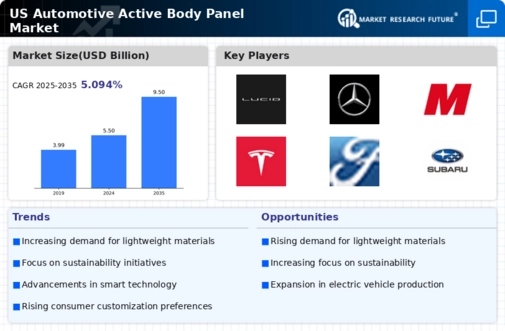Rising Demand for Lightweight Materials
The automotive active-body-panel market is experiencing a notable shift towards lightweight materials, driven by the need for improved fuel efficiency and reduced emissions. As regulations tighten, manufacturers are increasingly adopting advanced materials such as aluminum and composites to enhance vehicle performance. This trend is reflected in the automotive industry, where lightweight vehicles can achieve up to 10% better fuel economy. The integration of these materials not only contributes to sustainability goals but also aligns with consumer preferences for eco-friendly vehicles. Consequently, the demand for lightweight active body panels is expected to grow, potentially increasing market value significantly in the coming years.
Advancements in Manufacturing Technologies
Innovations in manufacturing technologies are playing a crucial role in the automotive active-body-panel market. Techniques such as 3D printing and automated assembly lines are enhancing production efficiency and reducing costs. These advancements allow for more complex designs and faster turnaround times, which are essential in meeting the evolving demands of consumers. For instance, the adoption of 3D printing can reduce production time by up to 50%, enabling manufacturers to respond swiftly to market changes. As these technologies continue to evolve, they are likely to drive growth in the automotive active-body-panel market, fostering a competitive landscape.
Increased Focus on Vehicle Safety Features
The automotive active-body-panel market is heavily influenced by the increased emphasis on vehicle safety features. As consumers become more safety-conscious, manufacturers are integrating advanced safety technologies into vehicle designs. Active body panels, which can adapt to impact forces, are increasingly being utilized to enhance crashworthiness. This trend is supported by data indicating that vehicles equipped with advanced safety features can reduce accident-related injuries by up to 30%. Consequently, the automotive industry is likely to invest more in active body panel technologies, thereby propelling market growth and innovation.
Consumer Preference for Enhanced Aesthetics
Aesthetic appeal is becoming a driving force in the automotive active-body-panel market, as consumers increasingly seek vehicles that reflect their personal style. The demand for customizable and visually appealing body panels is on the rise, prompting manufacturers to explore innovative designs and finishes. This trend is evident in the growing popularity of vehicles with unique color options and textures, which can enhance brand identity. As the automotive industry adapts to these consumer preferences, the market for active body panels is expected to expand, with manufacturers investing in new technologies to meet aesthetic demands.
Regulatory Pressure for Emission Reductions
The automotive active-body-panel market faces significant pressure from regulatory bodies to reduce vehicle emissions. Stricter emission standards are compelling manufacturers to innovate and adopt technologies that minimize environmental impact. Active body panels that contribute to weight reduction and improved aerodynamics are becoming essential in meeting these regulations. For example, vehicles that comply with the latest emission standards can achieve reductions of up to 25% in CO2 emissions. As regulatory frameworks continue to evolve, the automotive industry is likely to prioritize the development of active body panels that align with these environmental goals, driving market growth.




















Leave a Comment